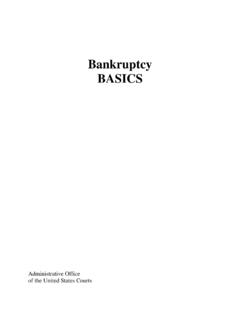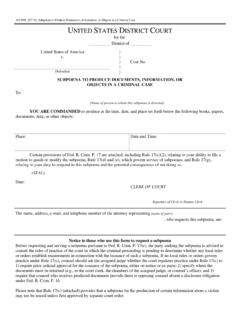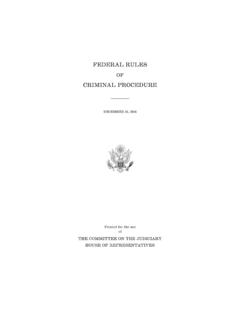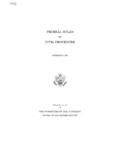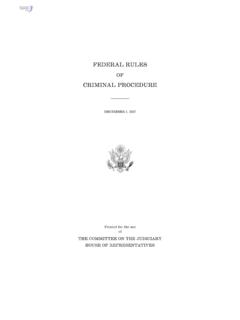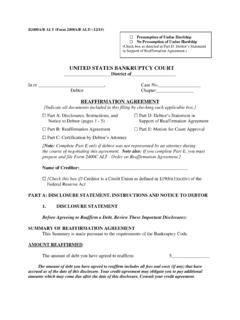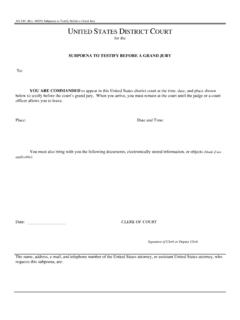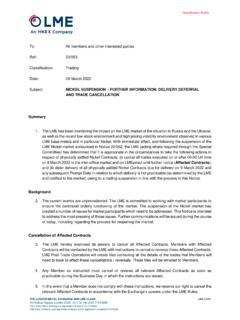Transcription of RULE OF LAW - United States Courts
1 RULE OF LAWA nalyze how landmark Supreme court decisions maintain the rule of law and protect These ResourcesRule of law overviewOpening questionsDiscussion questionsCase SummariesExpress Unpopular Views:Snyder v. Phelps (military funeral protests)Johnson v. Texas (flag burning)Participate in the Judicial Process:Batson v. Kentucky (race and jury selection) v. Alabama (gender and jury selection)Exercise Religious Practices:Church of the Lukumi-Babalu Aye, Inc. v. City of Hialeah (controversial religious practices)Wisconsin v. Yoder (compulsory education law and exercise of religion)Access to Education:Plyer v. Doe (immigrant children)Brown v. Board of Education (separate is not equal)Cooper v. Aaron (implementing desegregation)How to Use These ResourcesIn Advance1. Teachers/lawyers and students read the case summaries and Participants prepare presentations of the facts and summaries for selected cases in the classroom of presentation methods include lectures, oral arguments, or the Classroom or CourtroomTeachers/lawyers, and/or judges facilitate the following activities:1.
2 Presentation: rule of law overview2. Interactive warm-up: opening discussion3. Teams of students present: case summaries and discussion questions4. Wrap-up: questions for understandingProgram Times: 50-minute class period; 90-minute courtroom program. Timing depends on the number ofcases selected. Presentations maybe made by any combination of teachers, lawyers, and/or students andstudent teams, followed by the discussion questions included in the Times:Teachers/Lawyers/Judges: 30 minutes readingStudents: 60-90 minutes reading and preparing presentations, depending on the number of casesand the method of presentation Venue: If the teacher would like to have a federal judge preside over the presentations, usethe court locator to find the nearest local OF LAW OVERVIEWMore than 200 years ago, Alexander Hamilton, James Madison, and John Jay published a series of essayspromoting the ratification of the United States Constitution now known as Federalist Papers.
3 In explaining theneed for an independent judiciary, Alexander Hamilton noted in The Federalist # 78 that the federal Courts "weredesigned to be an intermediate body between the people and their legislature" in order to ensure that the people'srepresentatives acted only within the authority given to Congress under the Constitution is the nation's fundamental law. It codifies the core values of the people. Courts have theresponsibility to interpret the Constitution's meaning, as well as the meaning of any laws passed by Congress. TheFederalist # 78 States further that, if any law passed by Congress conflicts with the Constitution, "the Constitutionought to be preferred to the statute, the intention of the people to the intention of their agents." "Nor does this conclusion by any means suppose a superiority of the judicial to the legislative power.
4 It onlysupposed that the power of the people is superior to both; and that where the will of the legislature, declared in itsstatutes, stands in opposition to that of the people, declared in the Constitution, the judges ought to be governed bythe latter rather than the former. They ought to regulate their decisions by the fundamental laws, rather than bythose which are not fundamental."The American democratic system is not always based upon simple majority rule. There are certain principles thatare so important to the nation that the majority has agreed not to interfere in these areas. For instance, the Bill ofRights was passed because concepts such as freedom of religion, speech, equal treatment, and due process oflaw were deemed so important that, barring a Constitutional Amendment, not even a majority should be allowed tochange of law is a principle under which all persons, institutions, and entities are accountable to laws that are:Publicly promulgatedEqually enforcedIndependently adjudicatedAnd consistent with international human rights Courts play an integral role in maintaining the rule of law, particularly when they hear the grievances voiced byminority groups or by those who may hold minority opinions.
5 Equality before the law is such an essential part of theAmerican system of government that, when a majority, whether acting intentionally or unintentionally, infringes uponthe rights of a minority, the court may see fit to hear both sides of the controversy in ResourcesThe Federalist PapersMark Dimunation talks about The Federalist Papers. The collection of 85 essays by Alexander Hamilton,James Madison, and John Jay were written between 1787 and 1788 to encourage the States to ratify DISCUSSION QUESTIONS1. How does the Constitution protect the impartiality of federal judges when they have to makeunpopular decisions in order to follow the rule of law?The Founders knew that various political majorities might try to adversely affect minorities. Therefore, when theywrote Article III of the Constitution, they gave federal judges life tenure, during good behavior, to reinforce theirprotection from majority pressures.
6 The Founders knew that judges would sometimes have to make unpopulardecisions on some of the most controversial issues of the day and, in light of this, the Founders thought thatfederal judges should be isolated from political and social pressures. 2. How can majority-democratic rule be reconciled with minority rights when the judiciary acts tosafeguard the rule of law?The protection of minorities is not undemocratic. As the existence of the Bill of Rights illustrates, the majority hasvoluntarily agreed to limit majority rule in certain areas because some rights are so cherished that, barring aConstitutional amendment, they should not be changed, even by majority vote. Moreover, the federal Courts arelimited by the text of the Constitution and applicable laws. Judges must look to the Constitution and these lawsto make their decisions they are not free to impose their own personal beliefs on others, but must always havea legal basis for their UNPOPULAR VIEWSS nyder v.
7 PhelpsTexas v. JohnsonWhat is Your Opinion?Summary of a First Amendment Landmark Supreme court case:Snyder v. Phelps 131 S. Ct. 1207 (2011)FACTS:Fred Phelps and his followers at the Westboro Baptist Church believe that God punishes theUnited States for its tolerance of homosexuality, particularly within the military. Todemonstrate their beliefs, Phelps and his followers often picket at military Snyder's son, Lance Corporal Matthew Snyder, was killed in the line of duty in Iraq in2006. Westboro picketed Matthew Snyder's funeral displaying signs that stated, for instance,"God Hates the USA/Thank God for 9/11," "Thank God for Dead Soldiers," and "Don't Prayfor the USA." The church notified local authorities in advance that they intended to picket thefuneral, staged the picket on public land adjacent to a public street, and complied with allpolice instructions.
8 Church members also sang hymns and recited Bible Albert Snyder could see the tops of the picket signs on the day of the funeral, hecould not read what was written on them and it was not until he saw a news story about thefuneral and the picketing that he became aware of the church's message. Snyder suedPhelps and the church claiming, among other things, that their actions caused him severeemotional distress. In defense, Phelps argued that his speech (the picketing and the signs)was protected under the Free Speech Clause of the First Amendment to the :Whether Westboro's signs and comments while picketing Matthew Snyder's funeral related tomatters of public concern and were, thus, entitled to greater protection under the FreeSpeech Clause of the First Amendment? :(Chief Justice Roberts) The Supreme court 's holding turned largely on its determination thatthe church was speaking on "matters of public concern" as opposed to "matters of purelyprivate significance.
9 " The court explained that "[s]peech deals with matters of public concernwhen it can 'be fairly considered as relating to any matter of political, social, or other concernto the community' or when it 'is a subject of general interest and of value and concern to thepublic.'" Speech on public issues is entitled to special protection under the First Amendmentbecause it serves the "the principle that debate on public issues should be uninhibited,robust, and wide-open."To determine whether the speech dealt with matters of public concern, the court examinedthe "content, form, and context" of the speech. The court noted that none of these factorswould determine the outcome of the case and that a court must evaluate all the circumstancesof the speech, "including what was said, where it was said, and how it was said."Even though some of the picket signs arguably targeted only the Snyder family, most of themaddressed issues regarding the moral conduct of the , the fate of the , andhomosexuality in the military.
10 As such, the "overall thrust and dominant theme" of the speechrelated to broader public issues. Furthermore, the church was picketing on public landadjacent to a public street. Finally, there was no pre-existing relationship between Westboro'sspeech and Snyder that might suggest that the speech on public matters was intended tomask an attack on Snyder over a private matter . Therefore, the court held that the Phelps andhis followers were "speaking" on matters of public concern on public property and thus, wereentitled to protection under the First :(Alito, J.) Justice Alito argued that the national commitment to free and open debate is not alicense for the vicious verbal assault that occurred in this case. He noted that "the FirstAmendment does not shield utterances that form 'no essential part of any exposition of ideas,and are of such slight social value as a step to truth that any benefit that may be derived fromthem is clearly outweighed by the social interest in order and morality.
